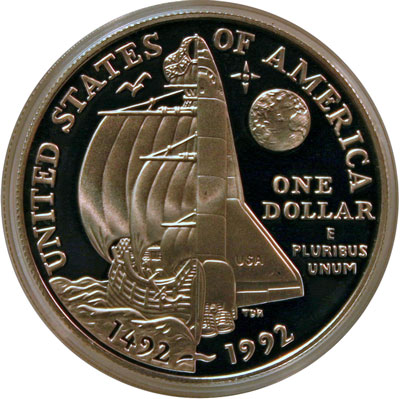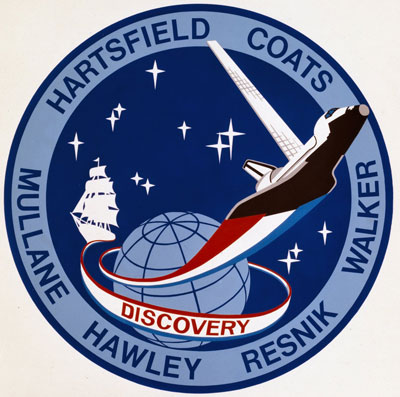In 1992, the US Mint produced three commemorative coins for the quincentenary to remember Christopher Columbus and his exploratory journey to the Americas in 1492. A clad half dollar, a silver dollar and a gold five dollar coin completed the three coins.
For its reverse, the commemorative silver dollar showed half of a sailing ship from the 15th century and half of a space ship from the 20th century. Thomas D. Rogers of the US Mint designed the split image of the Santa Maria, Columbus’ largest ship, and the US Space Shuttle Discovery.
The contrast showed both the remarkable advances mankind made in less than 500 years. It also illustrated frontiers remained to be explored.
Interestingly, though, this design was not the first to show both a sailing ship of yesteryear and a ship exploring space.
Eight years before the Columbus dollar, the Shuttle Discovery launched into space on its first journey.
From NASA’s August 1984 PressKit, “The insignia for the STS-41D mission features the Discovery, NASA’s third orbital vehicle, as it makes its maiden voyage. The ghost ship represents the orbiter’s namesakes which have figured prominently in the history of exploration. The space shuttle Discovery heads for new horizons to extend that proud tradition.”
In addition, the surnames for the crewmembers of NASA’s eleventh Space Shuttle mission encircle the red, white, and blue scene. And, the twelve white stars symbolize the Discovery’s STS-41D mission as the 12th NASA shuttle mission.
The “ghost ship” on the mission insignia represents four different sailing ships named Discovery from the early 1600s to the early 1900s.
The oldest was Henry Hudson’s Discovery used in 1610-11 to search for a northwest passage to the Orient. Three years earlier, the ship had been used to found Jamestown, the first permanent English settlement in the New World.
Next, Captain James Cook commanded the HMS Discovery during his final major voyage of exploration from 1776-1779.
Third, another HMS Discovery with Captain George Nares carried a British Arctic Expedition in 1875-6 to the North Pole.
Fourth, the RRS Discovery with Captain Robert Falcon Scott and Ernest Shackleford was the namesake ship for the 1901-4 Discovery Expedition to Antarctica. That Royal Geographical Society research ship is still preserved as a museum.
In February of this year, the Shuttle Discovery made her thirty-ninth and last flight in her 27 years of service. After being decommissioned in March and a period for decontamination, the Shuttle Discovery will also make her way to a museum, the Smithsonian.
Now, the unanswered question remains, did Mr. Rogers get his idea from insignia of the first Shuttle Discovery Mission, STS-41D?
The answer is not important. Both designs, the shuttle mission insignia and the Columbus Commemorative Silver Dollar coin, show creativity and provide a telling message.

